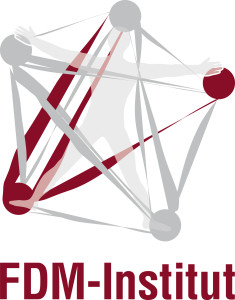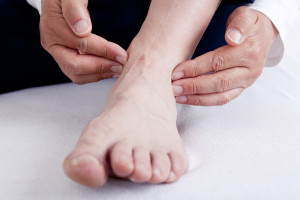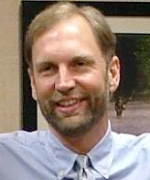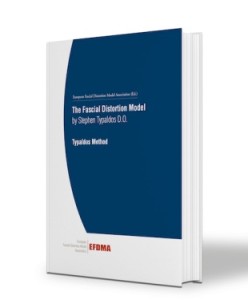The course is addressed to Physiotherapists and other Health Professionals.
Course’s language is English with simultaneous translation to Greek.
EPIMORFOSIS, intends to organize the 1st Module of “Fascial Distortion Model (FDM)”, Typaldos Method under the auspices of EFDMA (European Fascial Distortion Model Association) with professor Markus Nagel.
The course lasts 3 days and will take in Athens.
The course fee is 450€.
In order to finalize your registration and ensure a placement to this seminar, a down payment of 200€ must be deposited.
The rest amount of 250€ must be deposited at least 2 days prior to the beginning day of the course.
The Fascial Distortion Model (FDM)


In FDM, the diagnostic process is based on three pillars of analysis. Particular attention is directed at a patient’s body language when describing pain. Intuitive gestures, when correctly interpreted, are direct indicators of fascial distortions. The patient’s case history as well as a series of examinations complete the FDM diagnosis.
The principles of FDM can be applied to a variety of different medical areas and expand the diagnostic options doctors and physiotherapists have at their disposal.
FDM enables an effective treatment of patients presenting with a variety of medical diagnoses, but at the present time, the FDM approach is primarily chosen for musculoskeletal complaints and chronic pain.
The term “Fascial Distortion Model (FDM)” is a combination of 3 different words:


Fasciae are structures of connective tissue. According to the FDM, they are the key to diagnosing and treating a variety of physical ailments. Today, medical science acknowledges the importance of fasciae in the human body, a fact backed up by a growing number of scientific studies into the FDM therapy model.
2. Distortion
Distortions are contortions, deformations or dislocations of fasciae. Each FDM therapy session aims to correct these distortions with specific techniques like the Typaldos Method manual therapy method. Once corrected, a considerable or complete reduction of pain will be noticeable to the patient.


The FDM is a clinical model. Through the collection of empirical data, Stephen Typaldos, D.O., FDM’s creator, developed a model representing the correlation of specific fascial distortions, traditional diagnoses and effective treatment options. Physicians and physiotherapists practicing FDM are utilizing the Fascial Distortion Model in order to arrive at a precise individual diagnosis and to choose a specific treatment.
FDM application
FDM is an individual and neutral approach. It enables the practicing physician or physiotherapist to choose the best treatment for the individual patient by re-evaluating traditional medical diagnostic tools by use of the Fascial Distortion Model (FDM).
The goal of each FDM therapy is an anatomical correction of the distorted fascia. As soon as the correction is achieved, an immediate improvement in strength, mobility and reduction of pain will be noticeable. Long periods of recovery (and therefore inactivity) are unnecessary and a fast return to physical activity is possible.
Stephen Typaldos, D.O. developed specific manual techniques and manipulation maneuvers. They form the basis of the so-called Typaldos Method and are taught in FDM seminars according to quality standards defined by the European Fascial Distortion Model Association (EFDMA).
The Typaldos Method has been used on patients with the following conditions:


- Acute pain due to sprained or dislocated joints
- Sports injuries like ligament strains, contusions, muscle fiber tears etc.
- Back and lower back pain, shoulder and neck spasms…
- Impaired mobility
- Symptoms like numbness, paresthesia, feelings of limb weakness or instability
- Certain ailments typically ascribed to internal medicine
Stephen Typaldos D.O. – FDM Pioneer


In 1991, Typaldos began to develop an entirely new diagnostic and treatment model by carefully monitoring his patients. Looking and listening to them closely, he recognized that patients intuitively know which therapy steps are particularly relevant to their recovery and express this by using characteristic gestures and phrases. He found that focusing his manual therapy on these indicators led to immediate and effective pain relief.
The results he saw encouraged Typaldos to describe in detail the FDM approach as well as the resulting therapy model and method of treatment. He revealed his findings in various medical journals and subsequently created and published his pioneering thesis on the Fascial Distortion Model (FDM) in several books.
Stephen Typaldos, D.O. died suddenly on April 5, 2006 at the age of 49. His pupils and colleagues in Europe, the US, Japan and Africa have been forming FDM associations ever since in order to safeguard acknowledged quality standards in FDM training as well as to enable an FDM-related cross-cultural knowledge exchange.
Bibliography
Published by the European Fascial Distortion Model Association (EFDMA)
Hard cover; Medical Manual, 216 pages, 77 illustrations, bound
Language: english
ISBN: 978-3-9502774-2-5
This up-to-date textbook on the fascial distortion model (FDM) according to Stephen Typaldos comprises the basics of the FDM and describes the use of the Typaldos method in practice. Corresponding to the curriculum of the European Fascial Distortion Model Association (EFDMA) the book explains the theory of the different fascial distortions, the FDM diagnosis and the manual application of the method to the locomotor system. In addition, it presents the historic development of the model and discusses the FDM treatment approach in comparison with the allopathic treatment approach.
European Fascial Distortion Model Association


The EFDMA sets certain standards in the education and promotion of the Fascial Distortion Model (FDM) in Europe and offers information on FDM, its basic principles and application in the treatment of a diverse range of ailments to medical professionals as well as patients.
Today, the EFDMA counts nearly 600 members in Germany, Austria, Italy, Poland, Luxemburg, Switzerland, Netherlands, Belgium, Russia, Hungary and Norway.
The EFDMA board is currently made up of seven physicians, osteopaths and physiotherapists working on a voluntary basis. All seven successfully use FDM and the Typaldos Method on their patients.
Curriculum
European Fascial Distortion Model Association
The curriculum of the European Fascial Distortion Model Association EFDMA modulates:
FDM Basic (modules 1-3),
FDM Basic Certificate (FDM BC),
Practical Training,
FDM Advanced,
FDM International Certificate (FDM IC) and
Training to become a certified FDM-Instructor.
FDM Basic is led exclusively by certified and qualified FDM-Instructors, which are educated in accordance with the guidelines of EFDMA curriculum.
Overview FDM training path
FDM_Trainingpath_EFDMA
FDM Basic is composed of 3 modules.
Each module consists of at least 20 units (UST).
Module 1 is the entry in the FDM training and must be completed first. Modules 2 and 3 can be completed in a different order, but it is recommended to visit module 2 before 3.
Module 1:
• Basic introduction to the Fascial Distortion Model (FDM)
• General examination and treatment principles
• Specific examination and treatment principles of shoulder, knee and ankle applying the Typaldos Method
Module 2:
• Refresher course and revision of basic knowledge
• Specific examination and treatment principles of pelvic area/hips, lower and middle back and neck applying the Typaldos Method
Module 3:
• Refresher course and revision of basic knowledge
• Specific examination and treatment principles of lower and upper extremities and the head area applying the Typaldos Method
Practical Training
Entrance criteria: completion of FDM Basic. The FDM Basic Certificate (FDM BC) is not a requirement. The Practical Training provide a revision and deepening of the FDM Basic contents. Detailed content is listed in the training calendar.
FDM Basic Certificate (FDM BC)
After completing modules 1-3, the final exam (FDM BC) can be taken.
A positive grade is a requirement for participation in further advanced FDM seminars.
In addition, the successful graduate is eligible to be added to the official list of FDM practitioners.
Participants are issued a certificate of participation recognized by EFDMA
%20’19%20–%20ΑΘΗΝΑΣ%20epimorfosis%20gr.png)
%20’19%20–%20ΑΘΗΝΑΣ%20epimorfosis%20gr.png)
Day 1
12.30 Registrations
13:00 Introduction into the FDM, history of the FDM, the person Stephen Typaldos
14:00 Definitions and terms: Fascia, Distortion, Model Understanding from fascia by Stephen Typaldos
15:00 Fascial distortions: Trigger band (TB), Herniated Trigger point (HTP), Continuum distortion (CD) with subtypes (eCD, iCD) Theoretical explanation: Continuum Theory
16:00 Fascial distortions: Folding distortion (FD) with subtypes (uFD, rFD), Cylinder distortion (CyD), Tectonic fixation (TF) Theoretical explanation: Fluid and tissue
17:00 Course of Fascial distortions: TB, HTP, CD, FD, CyD, TF Theoretical explanation: The term “chronic” in the FDM
18:00 Diagnosis of Fascial distortions: TB, HTP, CD, FD, CyD, TF Three diagnostic pilars: Gesture (body language), anamnesis (subjective complaints, mechanism of injury), examination (objective findings)
19:00 End day 1
Day 2
9:00 General Treatment of Fascial distortions / Typaldos method: TB (Trigger band technique), HTP (HTP technique) Analogy: Ziplog bag, „bring cows in the barn!“
11:00 Live treatment patients (2)
12:00 General Treatment of Fascial distortions / Typaldos method: CD (Continuum technique), FD (traction and compression)
13:00 Lunch break
14:00 General Treatment of Fascial distortions / Typaldos method: CyD (manual and tool associated treatment), TF (tectonic pump) Analogy: Cyber locks, slinky
16:00 Live treatment patients (2)
17:00 General information on the treatment of Fascial distortions; Indications and contraindications
18:00 End day 2
Day 3
9:00 Specific examination and treatment: shoulder Specific treatment strategy for the shoulder
11:00 Live treatment patients (2)
12:00 Specific examination and treatment: ankle Specific treatment strategy for acut sprained ankle Theoretical explanation: Ligament injuries of fractures at the ankle
13:00 Specific examination and treatment: knee Theoretical explanation: Injured menisci or cross bands
14:00 End day 3
1. Credit or Deposit card payment
You can deposit the down payment or the total fee via credit or deposit card (Visa, Mastercard & American Express) from the webpage of each course, through VivaPayments.
You are solely responsible for the proper entry and the genuineness of your credit/deposit card’s details. EPIMORFOSIS bears no responsibility in case of any error.
Any payment commission is charged to EPIMORFOSIS
2. Deposit – Transfer to our bank account.
You can deposit or transfer the requested amount for your registration to the following accounts, writing your full name in the field “Reason for the Beneficiary”:
PIRAEUS BANK:
ΙΒΑΝ: GR5501722380005238070348955
SWIFT(BIC): PIRBGRAA
NATIONAL BANK of GREECE:
IBAN: GR6801102170000021744103439
SWIFT(BIC): ETHNGRAA
ALPHA BANK :
ΙΒΑΝ: GR4801407080708002002013410
SWIFT(BIC): CRBAGRAA
EUROBANK:
ΙΒΑΝ: GR4502600370000010201090153
SWIFT(BIC): ERBKGRAA
Beneficiary: EPIMORFOSIS KENTRO EPIMORFOSIS STELECHON YGEIAS OE
The bank transfer fee charged to EPIMORFOSIS
1. A certificate of attendance, a degree or a diploma will be issued.
2. Printed handouts are provided (notes or relevant book).
3. In case of cancellation of the seminar due to EPIMORFOSIS’s responsibility, deposited fees will be refunded immediately.
4. EPIMORFOSIS reserves the right to change the date or postopone seminars, informing participants by phone and / or sms & e-mail. In such a case participants are entitled to request full refund of their fees if they do not wish to attend the seminar on the new date or to use this amount for their participation in other seminars or services of the company.
5. In the event of a strike, government’s bans, heavy bad weather, and generally any event beyond the reasonable control of the organisers which impedes the execution of part or all of the seminar, the organizers reserve the right to change the date and time of the event. In this case the fees are not refundable but are valid as they are.
6. Cancellation of participation due to participant’s responsibility is possible only by email, as follows:
• up to 30 days prior to the start of the seminar, all deposits are refundable.
• up to 15 days prior to the start of the seminar, 50% is refundable.
• no refund after this deadline, exceptions could be only by decision of EPIMORFOSIS.
7. The realisation of the course will be confirmed by email or/and sms to be sent to participants, in time.
8. It is advised to not buy your flight tickets until you receive this confirmation email (or/and sms).
9. LLC-1 EPIMORFOSIS keeps the right to change course venues.
You can make your own reservation declaring the name of Epimorfosis.
Hotel Delfini** single room B&B .
More information: Tel.: +30 210 94 15 364 & 94 15 373


Fascial Distortion Model Module 1 – FDM1 (Typaldos Method) – ΑΘΗΝΑ 2024
€200.00 – €450.00
EPIMORFOSIS organizes specialization seminars for rehabilitation professionals. I’ve watched a lot. I strongly recommend you trust EPIMORFOSIS for your specialization and lifelong information.
Training, a steady value for more than twenty years now, leads physiotherapy and keeps it at a very high level, well done to George Karambalis and his associates, we owe a lot to all of you.
The best physiotherapists training institution. It enables the development of the necessary knowledge for clinical reasoning. High-quality training without having to travel abroad.
My first steps in professional specialization started with EPIMORFOSIS and continue. It has been with us all these years, covering the need for modern and documented knowledge, in collaboration with internationally acclaimed educational institutions.
I have known George Karampalis and EPIMORFOSIS for many years. I’ve had the opportunity to join several clinical courses and I can argue that, at the level of organisation and selection of trainers, they have a high level of recognised prestige.
EPIMORFOSIS justifies its name by providing high quality courses. George Karampalis operates more like a constant “trainee” and less like an entrepreneur, and this is an additional positive fact in the effort that is put by the workers and teachers of EPIMORFOSIS.



